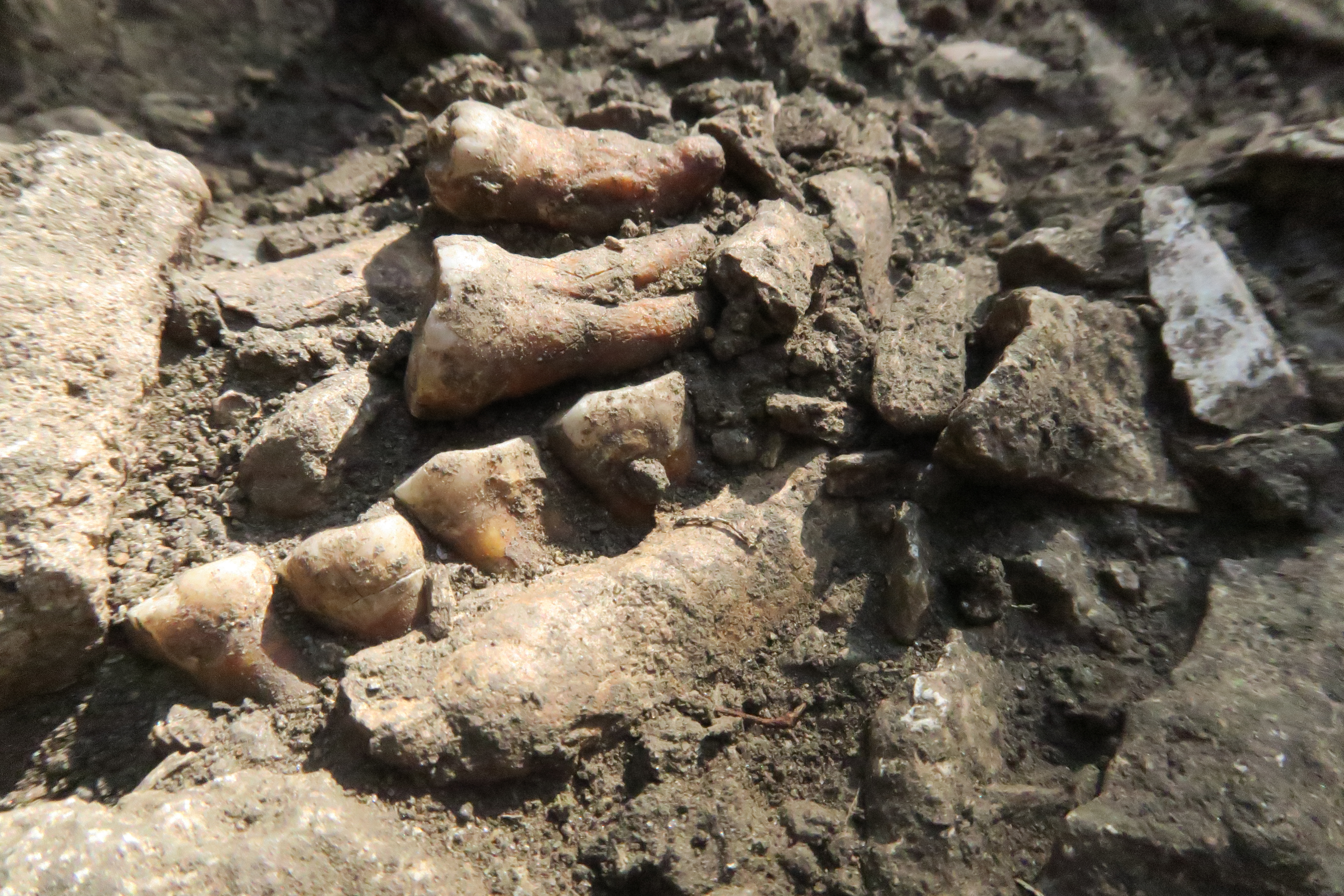Extinction
Ants Farmed Fungi in the Wake of Dinosaurs’ Demise 66 Million Years Ago
A new study from Smithsonian scientists analyzes ant and fungus species, and uncovers the origins of their close partnership
Divers in Mexico's Underwater Caves Get a Glimpse of Rarely Seen Artifacts, Fossils and Human Remains
Cenotes in the Yucatán Peninsula are time capsules preserving remnants of Maya culture and fossils of extinct megafauna
Extinct Volcanoes May Be an Untapped Source of Rare Metals
Unexplored iron-rich magma could help power current and future technologies
Rare and Elusive Australian Bird, Once Thought Extinct for 100 Years, Discovered by Indigenous Rangers and Scientists
Using sound recordings, the team identified the largest known population of the night parrot, a secretive species known as the "Holy Grail of birdwatching"
Rare Jaw Fossils Discovered in Texas Shed Light on a 20-Foot-Long Mosasaur
Unearthed last year, the remains could reveal new information on the extinct sea reptile, which crushed mollusks and shelled creatures with its large, round teeth
In Case Humans Go Extinct, This Memory Crystal Will Store Our Genome for Billions of Years
Scientists have created "a form of information immortality" meant to instruct future species on how to recreate humans. But who, or what, will find it?
Ancient DNA Reveals Neanderthal Group Was Isolated for 50,000 Years
A new study, based on the remains of a Neanderthal nicknamed Thorin, is shaking up what archaeologists long thought about these early humans in Europe
The Surprising Link Between Bats Dying and Human Infant Mortality
A new study finds that when bats in U.S. counties were decimated by the deadly white-nose syndrome, human deaths followed closely behind
Miners Unearth a Mummified Woolly Rhino in Siberia, With an Intact Horn and Soft Tissue
The rare discovery will help scientists find out more about the prehistoric animal’s development, diet and living conditions
20,000-Year-Old Columbian Mammoth Bones Discovered in Texas
While fishing at an undisclosed lake, Sabrina Solomon slipped and fell—and came face to face with the remains
These 'Lost' Bird Species Haven't Been Seen in at Least a Decade—and Scientists Want Help Finding Them
Some of the 126 species on their list haven’t been photographed or recorded in more than century
13,600-Year-Old Mastodon Skull Uncovered in Iowa
The hulking creature may have overlapped with Indigenous people
Asteroid That Ended the Dinosaurs Came From Beyond Jupiter, Study Finds
Metal isotopes delivered to Earth by the asteroid reveal it's consistent with space rocks formed in the outer solar system
3D DNA Preserved for 52,000 Years in Freeze-Dried Woolly Mammoth Remains
For the first time, researchers have mapped ancient genetic material in unprecedented detail
Has Life on Earth Survived More Than Five Mass Extinctions?
Scientists aren’t just arguing whether humans are causing a sixth mass extinction event now, but whether many more occurred in the past
What Killed the Last Woolly Mammoths? Scientists Say It Wasn't Inbreeding
New research suggests some catastrophic event—such as a natural disaster or a virus—killed the world's last known population of mammoths on Wrangel Island
'Frog Saunas' May Be the Key to Saving Amphibians From a Deadly Fungal Infection
Providing frogs with sun-warmed bricks inside mini-greenhouses can help them recover from chytrid and make them more resilient against the disease in the future, a new study finds
A Giant Interstellar Cloud May Have Once Enveloped Earth, Potentially Causing Ice Ages
Astronomers suggest this cold, dense cloud compressed our sun's protective field between two and three million years ago, leaving the Earth exposed to cosmic material
Meet the 'Echidnapus,' an Extinct Creature That Resembles Both the Echidna and Platypus of Today
The species is among three newly identified monotremes, or egg-laying mammals, discovered from fossils in Australia that are shedding light on the odd animals' evolution
More Than a Century Ago, Flamingos Disappeared From Florida. Now, They're Coming Home
Likely transported by Hurricane Idalia last August, more than 100 of the pink birds were counted in a February census in the Sunshine State, where they are considered a native species
Page 1 of 18
:focal(1500x957:1501x958)/https://tf-cmsv2-smithsonianmag-media.s3.amazonaws.com/filer_public/2d/1b/2d1b50a7-3121-456f-9922-3ce10ed44ec9/a_-_ted_schultz_-_a_lower_agriculture.jpg)
:focal(1000x662:1001x663)/https://tf-cmsv2-smithsonianmag-media.s3.amazonaws.com/filer_public/59/44/5944fdd6-8215-4a86-854f-782ec0b2e58e/martin_broen_page22.jpg)
:focal(3583x2560:3584x2561)/https://tf-cmsv2-smithsonianmag-media.s3.amazonaws.com/filer_public/4f/70/4f70ffc0-086f-4b51-9748-10dd4c9ed1db/pexels-blaremc-9496447.jpg)
:focal(512x288:513x289)/https://tf-cmsv2-smithsonianmag-media.s3.amazonaws.com/filer_public/b2/73/b2730dfc-7061-4658-a36a-c7dffe1be220/bird.jpg)
:focal(425x320:426x321)/https://tf-cmsv2-smithsonianmag-media.s3.amazonaws.com/filer_public/21/4f/214fb752-d077-486e-a6b2-dca284c50163/globidens-alabamaensis.jpeg)
:focal(1024x575:1025x576)/https://tf-cmsv2-smithsonianmag-media.s3.amazonaws.com/filer_public/5a/e2/5ae236c1-dbe7-48a0-9b08-03e71a9e2590/skynews-genome-5d-crystal_6689808.jpg)

:focal(1752x1168:1753x1169)/https://tf-cmsv2-smithsonianmag-media.s3.amazonaws.com/filer_public/fa/a5/faa51fb1-20a7-4e91-b66e-fa6f07d81150/6950623578_064d5a166b_o.jpg)
:focal(500x333:501x334)/https://tf-cmsv2-smithsonianmag-media.s3.amazonaws.com/filer_public/d6/19/d6199f35-763b-47e4-a469-43488f0b271f/horn.jpeg)
:focal(2550x1676:2551x1677)/https://tf-cmsv2-smithsonianmag-media.s3.amazonaws.com/filer_public/b1/91/b1911093-3194-4c0d-81cb-a5b0a8a87ccf/gettyimages-1751778506.jpg)
:focal(800x450:801x451)/https://tf-cmsv2-smithsonianmag-media.s3.amazonaws.com/filer_public/15/7a/157a04b2-c7e7-44ab-8948-73498602bac3/black-naped-pheasant-pigeon-by-doka-nason_american-bird-conservancy_1600x900.png)
:focal(800x602:801x603)/https://tf-cmsv2-smithsonianmag-media.s3.amazonaws.com/filer_public/65/56/6556d7d4-ce47-456b-b9f3-5611778ecb2f/2024_08_06-mastodon-dig-006.jpg)
:focal(2791x1781:2792x1782)/https://tf-cmsv2-smithsonianmag-media.s3.amazonaws.com/filer_public/9a/9a/9a9a1da9-da4f-43a5-8a09-f7146fabb8d3/gettyimages-713781277.jpg)
:focal(600x400:601x401)/https://tf-cmsv2-smithsonianmag-media.s3.amazonaws.com/filer_public/9d/03/9d03e8f0-5b0e-4445-b90a-69b96ccf49b0/imrs_1.png)
:focal(800x602:801x603)/https://tf-cmsv2-smithsonianmag-media.s3.amazonaws.com/filer_public/89/bb/89bbc077-3a82-480c-99e6-0758e58f3e74/massextinctions.jpg)
:focal(1280x817:1281x818)/https://tf-cmsv2-smithsonianmag-media.s3.amazonaws.com/filer_public/03/54/0354cbb8-1c5f-4d56-856b-1789f070550b/mammoth-tusk-on-wrangel-island-2017-photo-love-dalen-scaled.jpg)
:focal(446x286:447x287)/https://tf-cmsv2-smithsonianmag-media.s3.amazonaws.com/filer_public/f9/f7/f9f713b6-b855-4bb0-8ea6-387a1c2da7a3/green-gold-bell-frogs-waddle-1200.jpg)
:focal(537x445:538x446)/https://tf-cmsv2-smithsonianmag-media.s3.amazonaws.com/filer_public/e8/b6/e8b68174-1c9b-465e-8469-b66151dd09fa/heliosphere.jpg)
:focal(517x379:518x380)/https://tf-cmsv2-smithsonianmag-media.s3.amazonaws.com/filer_public/5a/2c/5a2c8abd-95de-4b9f-a80a-045996094de7/age_of_monotremes__echidnapus_bottom_right_ilustration_by_peter_shouten.jpeg)
:focal(1500x1000:1501x1001)/https://tf-cmsv2-smithsonianmag-media.s3.amazonaws.com/filer_public/aa/fd/aafd53cf-c15c-4e26-9abd-fc3036574298/gettyimages-959583750.jpg)